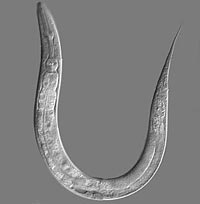Regulatory network balances stem cell maintenance, differentiation
While much of the promise of stem cells springs from their ability to develop into any cell type in the body, the biological workings that control that maturation process are still largely unknown.

Research with the tiny roundworm Caenorhabditis elegans has led to a new model of stem cell regulation. Researchers at UW–Madison led by biochemistry professor Judith Kimble have described how a network of regulatory factors helps maintain a balance between stem cells and mature daughter cells. Understanding these factors, many of which also control stem cells and development in humans, should help guide efforts to study human stem cells.
Photo: courtesy Judith Kimble
Writing in the online edition of the Proceedings of the National Academy of Sciences this week (Jan. 11), scientists from UW–Madison and the University of California-Irvine present a new model of stem cell regulation.
Working with the small roundworm Caenorhabditis elegans, the researchers describe how a network of regulatory factors can maintain a stable pool of stem cells while launching a second pool of cells on the path toward maturing into differentiated cells with specific functions.
“This gives us a different way to think about how stem cells are controlled to leave their stem cell state and enter into a differentiated state,” says Judith Kimble, a Howard Hughes Medical Institute investigator and UW–Madison professor of biochemistry who led the study.
“I think the basic principle is one that is very broadly applicable. The regulatory network is geared to define two states — the stem cell state and the differentiated state — and it’s the regulation of that network that’s important,” Kimble says. “My guess is that this will also be true in other stem cell systems.”
Regulation of the transition from stem cell to mature cell is important for a number of reasons, she says. Disruption of the balance between the two states could lead to tumors or loss of the ability to maintain healthy tissues.

Kimble
Using the relatively simple worm allows them to study how stem cell populations respond to various physiological parameters in a whole animal and should help guide efforts to harness their blank-slate properties and to understand human diseases.
“Looking in vivo at how a stem cell is controlled to go from one state to another is really important if you want to intervene or engineer. This provides us a new way of thinking about it,” Kimble says.
The new model also describes how a previously identified intermediate population of cells, possessing some properties of each state, probably reflects a gradual maturation process.
The specific factors that trigger cells to leave the stem cell state and begin to differentiate are still unknown, the scientists say, but the network of known regulatory factors already well understood in the worm provides several possibilities.
“Many of the same molecules control stem cells and development in humans and are involved in aberrant conditions,” such as leukemia and other cancers, Kimble says. “We hope to establish a procedure for understanding them in more complex systems.”
In addition to Kimble, the paper was authored by Sarah Crittenden, Olivier Cinquin and Dyan Morgan. Additional funding was provided by the National Institutes of Health.




